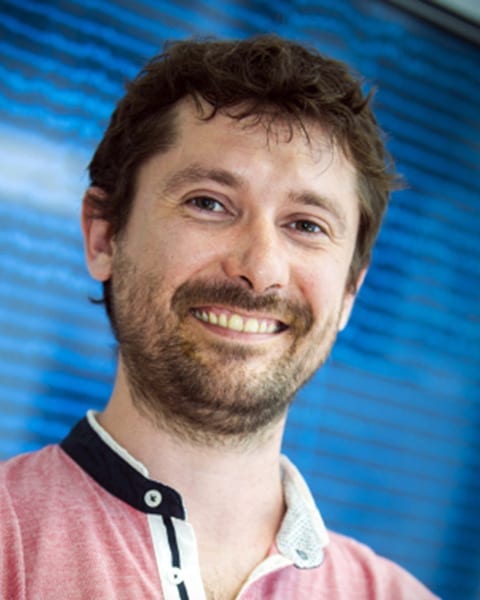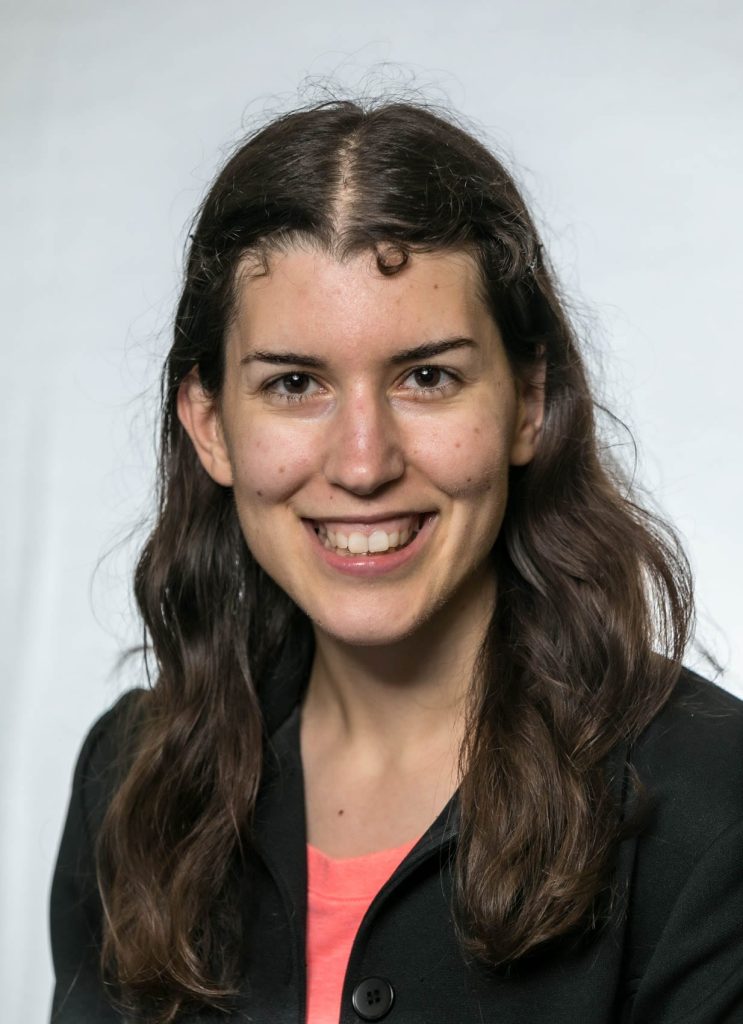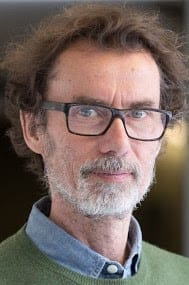News
May 10, 2021
Interview with our four new professors
Eilif Benjamin Muller
What are your research interests?
 I direct the Architectures of Biological Learning Lab at the CHU Ste-Justine, where our research is focused on understanding the processes of learning in the mammalian brain region known as the neocortex using computational and mathematical approaches. This region is particularly developed in humans, making up about 3/4 of our brains, and containing an estimated 100 trillion synapses. These points of communication between neurons undergo persistent changes in connectivity as a function of our experiences, a process known as synaptic plasticity which is thought to be the basis of how we learn.
I direct the Architectures of Biological Learning Lab at the CHU Ste-Justine, where our research is focused on understanding the processes of learning in the mammalian brain region known as the neocortex using computational and mathematical approaches. This region is particularly developed in humans, making up about 3/4 of our brains, and containing an estimated 100 trillion synapses. These points of communication between neurons undergo persistent changes in connectivity as a function of our experiences, a process known as synaptic plasticity which is thought to be the basis of how we learn.
Our research aim is to develop a quantitative and integrated understanding of how learning emerges from synaptic plasticity in the neocortical network architecture by connecting two scales of mathematical description: (1) computer simulations of the relevant biological processes with (2) the rich conceptual frameworks provided by modern artificial intelligence (AI) research. By bridging these two scales, we aim to provide a deeper fundamental understanding of the causal mechanisms underlying learning function and dysfunction, and contribute to developing innovative personalised treatments of associated disorders, such as autism spectrum disorder and schizophrenia, that address the underlying cause.
Can you share with us a fun fact about you and/or your motto?
Viktor Frankl, a neurologist, psychiatrist and holocaust survivor said “The meaning of life is to give life meaning.” These are profound words of positivity I endeavor to live for every day. To help myself along the way, I drink copious amounts of Darjeeling tea. Until my arrival in Montreal in 2019, I had no idea that I also absolutely adore smoked meat poutine. Searching for a compromise between Leif and Eli, my parents unintentionally gave me a first name which means eternal in Icelandic.
What would be your ideal collaborative research project?
Collaborative projects are such an important part of my approach to science, I wouldn’t dare pick a favourite! I spent almost two decades as a researcher in Europe, where there is a strong focus on funding for collaborative interdisciplinary team-science projects between EU member countries. In my experience, science is much more fun and productive in such diverse teams, because each researcher brings their unique perspective and complementary expertise. This is especially true for a subject matter as complex as learning in the brain.
It was the vibrant & collaborative Neuroscience and AI communities around McGill, UdeM, Mila, IVADO, and initiatives like UNIQUE (Union Neurosciences et Intelligence Artificielle – Québec) that originally attracted me to Montreal. Team funding is an important facilitator of collaborative research, and so I think programs like the UNIQUE-IVADO Neuro-AI Team Grant are an excellent step in the right direction. Together with Neuroscientist Prof. Roberto Araya (UdeM/CRCHUSJ), and AI researchers Profs Irina Rish (UdeM/Mila) and Doina Precup (Mila/McGill/DeepMind) we submitted an exciting project on Neocortical mechanisms of continual learning. If it gets funded, it would be ideal!
Studying associated disorders, such as schizophrenia and autism spectrum disorder, provides rich multi-model insight into neocortical learning mechanisms by revealing modes of disruption spanning scales from genes to cognition. This is a complementary direction for collaborative research projects with clinical psychiatrists, neurogenomicists, molecular biologists and experimental neuroscientists that I’m very excited about because of the potential to help people by contributing to the development of more timely, specific and effective treatments. Of course our analysis approaches contribute only one piece in the larger puzzle. The recently announced major initiative “Centre IMAGINE” at the CHUSJ, directed by Profs Patricia Conrod and Dr. Gregory Lodygensky, provides an excellent collaborative context in Montréal for the realization of this project.
Guillaume Dumas
What are your research interests?
 At the fundamental level, I am primarily interested in understanding how our brains allow us to interact dynamically with others and how our social abilities make human cognition so unique. This involves the development of two new co-dependent research fields: multi-brain neuroscience and social artificial intelligence. On a practical level, my team combines the recording of brain activity of several people simultaneously (hyperscanning). We also study interactions between humans and artificial agents, more recently via mixed reality video games. We are also developing machine learning methods to combine these new forms of observations with clinical and genomic data in order to apply this knowledge in the field of precision psychiatry, particularly in neurodevelopmental disorders with alterations of social cognition such as autism. Finally, in the long term, we aim to design new forms of artificial intelligence with social capabilities.
At the fundamental level, I am primarily interested in understanding how our brains allow us to interact dynamically with others and how our social abilities make human cognition so unique. This involves the development of two new co-dependent research fields: multi-brain neuroscience and social artificial intelligence. On a practical level, my team combines the recording of brain activity of several people simultaneously (hyperscanning). We also study interactions between humans and artificial agents, more recently via mixed reality video games. We are also developing machine learning methods to combine these new forms of observations with clinical and genomic data in order to apply this knowledge in the field of precision psychiatry, particularly in neurodevelopmental disorders with alterations of social cognition such as autism. Finally, in the long term, we aim to design new forms of artificial intelligence with social capabilities.
Can you share with us a fun fact about you and/or your motto?
My work on inter-brain synchronizations was at first considered as parapsychology.
What would be your ideal collaborative research project?
An action research project with the autism community on the use of serious video games.
Sarah Gagliano Taliun
What are your research interests?
 My research interests are to use and develop computational methods to better understand the genetic factors that contribute to the development of multifactorial diseases using big data. This work aims to support personalized health in terms of prevention, diagnosis and treatment.
My research interests are to use and develop computational methods to better understand the genetic factors that contribute to the development of multifactorial diseases using big data. This work aims to support personalized health in terms of prevention, diagnosis and treatment.
Can you share with us a fun fact about you and/or your motto?
I have a twin. That’s one of the reasons why I think genetics is a fascinating field.
What would be your ideal collaborative research project?
This would be a multidisciplinary project for which I could travel to Italy to exchange ideas with my collaborators and to participate in the training of the next generation of researchers.
Tomas Paus
What are your research interests?
 I am a systems neuroscientist, with core expertise in structural and functional organization of the human brain. I extend this knowledge to both the molecular (omics) and population (geospatial mapping of social environment) levels.My work integrates epidemiology, neuroscience and genetics – through a new discipline of population neuroscience (https://www.google.ca/books/edition/Population_Neuroscience/JPQtorlqv3cC?hl=en&gbpv=0) – in the pursuit of knowledge relevant for child and youth brain health. This research draws on data acquired in a number of cohorts based in North and South America and Europe.
I am a systems neuroscientist, with core expertise in structural and functional organization of the human brain. I extend this knowledge to both the molecular (omics) and population (geospatial mapping of social environment) levels.My work integrates epidemiology, neuroscience and genetics – through a new discipline of population neuroscience (https://www.google.ca/books/edition/Population_Neuroscience/JPQtorlqv3cC?hl=en&gbpv=0) – in the pursuit of knowledge relevant for child and youth brain health. This research draws on data acquired in a number of cohorts based in North and South America and Europe.
Can you share with us a fun fact about you and/or your motto?
I love science. Discovering what no-one else knows (until you read a paper on BioRxiv…). I started as a teenager, giving Vitamin C (or placebo) to my classmates and testing their attention. This was my first paper. Over 30 years ago, I was lucky to come to Montreal and work with Brenda Milner, Michael Petrides and others at the Montreal Neurological Institute – at the time when brain imaging was taking off. Very exciting times… Science is all about new concepts build on data acquired with new tools. This is why AI is such a powerful engine of new discoveries.
What would be your ideal collaborative research project?
Collaboration with those who know what I don’t know – and are willing to engage in a conversation. Finding a common language is a key starting point. Then we can begin working together. In the near future, I will be looking for partners in two areas: (1) Extracting quantitative information about social environment (at a neighbourhood level) from “digital footprint” we leave behind by our actions (current and past); and (2) Modelling variations in neural micro-circuits across different regions of the primate cerebral cortex.